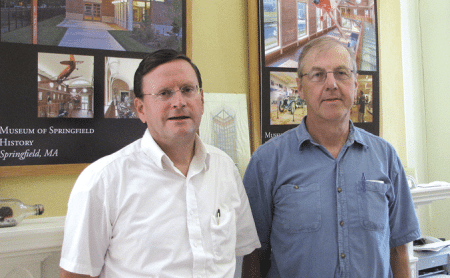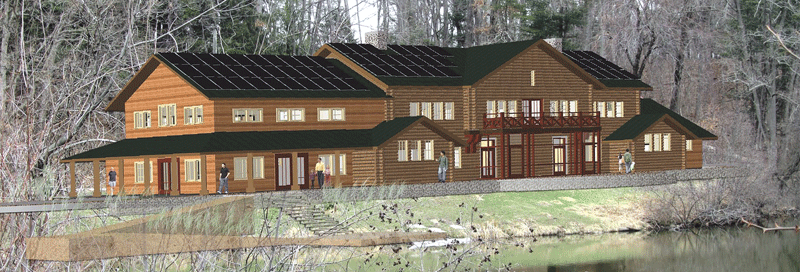Urban Renewal
Jablonski DeVriese Architects Strives to Preserve the Past

Steve Jablonski, left, and Brian DeVriese say the Northeast offers a rich lode of opportunity in preservation and renovation work.
Take, for example, the Clifford A. Phaneuf Environmental Center at Forest Park, which has housed the Environmental Center for Our Schools (ECOS) program — utilized by thousands of Springfield public-school students and teachers annually — since 1970.
The structure was built in the 1930s as a warming house for ice skaters, Jablonski said. “It was built by the Springfield DPW, right after the Depression, but it’s basically sat there for 70, 80 years without any renovation whatsoever.”
Hence the $2.5 million expansion and renovation expected to go out to bid to contractors soon. The plan is to update the building and bring it up to safety codes; provide space for revenue-generating activities during after-school hours, weekends, and the summer months; and incorporate ‘green’ technologies such as a hydro-geothermal HVAC system; cutting-edge insulation; and energy-efficient windows, all of which will contribute to the project’s LEED Silver rating.
“It’s a fairly major expansion and renovation,” Jablonski said before detailing how the design reflects all three elements of Jabonski DeVriese Architects.
“We’re preserving it, maintaining its character; we had to submit documentation to the Mass. Historical Commission,” he explained. “We’re adapting it because it wasn’t originally designed as an educational facility. And we’re renewing it by adding on and preparing for the future.”
Nearby, however, another project at Forest Park does none of those things. The firm has designed a new storage facility for the Bright Nights displays, which Spirit of Springfield had been keeping in a ramshackle horse barn.
“Preserve, adapt, renew isn’t practical in this case because all the posts are rotted, and there aren’t any character elements to this horse barn,” Jablonski said, although the new structure will include classrooms for a skills-training center for the manufacturing and contstruction trades, part of a federally funded workforce-training program that will involve local unions, Springfield Technical Community College, Roger L. Putnam Vocational Technical Academy, and the Regional Employment Board of Hampden County.
So, yes, there is some ‘adapting’ going on.
“It’s kind of a niche market that’s prevalent in Western Mass., and in the Northeast in general — historical-preservation projects, adapting, preserving, renewing,” Jablonski told BusinessWest. When he and DeVriese merged their solo practices in 2011, “we figured, well, everyone seems to have a specialty. We were trained to do anything. But people want to know if you have a specialty now.”
Simply put, he said, “we preserve old buildings. It’s something that’s really starting to grab hold in society. Preservation is good. People are moving back to urban areas. Mid-size cities that have architectural character, like Springfield, are on their way up, no matter what people say about the city. I live in Springfield, I was born here, and I’m a big fan of Springfield. That’s not to say that problems don’t exist, but it’s on its way up. ”
When some people see a neglected building, DeVriese added, their first instinct is to knock it down, but he and and his partner see potential — not just to maintain and enhance the strucutre’s architectural heritage, but to improve its environmental impact. “After all,” he said, quoting noted architect Carl Elefante, “the greenest building is the one already standing.”
For this issue’s focus on architecture, Jablonski and DeVriese talked with BusinessWest about some specific ways in which they’ve preserved some of the region’s heritage by putting their names to some truly unique projects.
Together Again
Jablonski had been working as a sole practitioner in Springfield since 1995, and DeVriese had managed a solo practice in Shelburne Falls since 1997, when they began collaborating on projects, notably the design of the Museum of Springfield History at the Quadrangle — a classic adaptive-reuse project, since it’s housed in a former Verizon office building.
“Steve approached me about helping with the Springfield Museums project, and that was a significant project for both of us,” said DeVriese. “We started doing more and more together over the years, and in 2011 we incorporated as partners. We were very, very busy at the time.”
For example, the museum project led to Springfield College hiring the firm for its complete renovation of Judd Gymnasia, renamed the Stitzer YMCA Center. For that design, Jablonski DeVries received the Paul E. Tsongas Award from Preservation Massachusetts, as well as the Springfield Preservation Trust Award for restoration and stewardship.
“For me, there was a lot more activity in this area than in Franklin County, an opportunity to work on larger projects with a longer duration,” DeVriese said. “I like Steve, and he’s great to work with.”
As for Jablonski, he said he’d occasionally been frustrated by a reluctance by state and municipal officials to award large contracts to solo architects — and he wanted an occasional day off. “For me, taking on a partner made a lot of sense, just having the ability to take a vacation and share the burden of production.
“To be honest, a lot of people advised me not to do it,” he continued. “To them, it was counterintuitive: ‘you started it, you should keep it to yourself and benefit from it.’ What they don’t realize is keeping it to yourself is not strategic; sure, you can keep it to yourself, and not get bigger projects, or run yourself into the ground because you can’t take vacations. You can have it all to yourself, but life isn’t as good.”
The pair made headlines soon after their merger when Springfield College — a long-time Jablonski client — tapped the firm to work with Erland Construction of East Windsor, Conn. to repair three residence halls hard hit by the June 2011 tornado.
The pair went through every room in every dorm and itemized all the damage to help the contractor develop a repair estimate. Once they decided the structures were salvageable, the architects and contractors had a significant challenge: to complete the work in 10 weeks, in time to house returning students.

A rendering of the new Clifford A. Phaneuf Environental Center at Forest Park, which houses an environmental-education program for Springfield students but hasn’t been renovated in more than 70 years.
Ten weeks and $5 million after the twister ripped through, little evidence remained of anything other than a summer remodeling job. That project earned a Rebuilding Project of the Year Award in 2012 from the New England chapter of the Construction Management Assoc. of America, which selected the effort from all renovation and modernization projects under $10 million.
College Try
Architectural design for college campuses is nothing new for the firm. “We’re identified really strongly with three or four sectors,” Jablonski explained, including higher education; municipal and government work, which includes schools, libraries, park buildings, and museums; and historical buildings of all kinds, which can cut across many sectors.
“It’s been harder than Brian and I ever thought to break into new markets,” he said, “but we both decided that we can’t put all our eggs in one basket — like the city of Springfield — especially when we have an economic downturn.”
That said, “I’d say about 90% of our clients are repeat customers,” he noted, citing Springfield College and the city of Springfield as two of the most long-standing, going back 20 years. “That says we have to be doing something right. It’s not just what drawings you do; it’s showing up on time and having some flexibility, because there’s always an issue, always some problem, so you have to be flexible. When we get repeat customers, we’re pretty sure we’re doing something right, or they’d go somewhere else. There’s definitely competition in the Valley.”
Jablonski said the firm is willing to do residential restoration, although they don’t actively market in that arena, but there isn’t enough of such work to make a living doing it exclusively. Still, “when someone approaches us, obviously we do it. We recently got a really nice, very large total rehab in Longmeadow.”
And they don’t limit themselves to high-profile jobs, recently taking on, for example, several dentistry offices and small projects for the city of Northampton, as well as preparing to tackle a cold-storage warehouse with a commercial kitchen on Warehouse Road in Springfield for the city’s school system, which recently expanded its free-lunch program to all students.
“I enjoy working with municipalities professionally and appreciate the quality of people involved in local government,” said DeVriese, who has been a selectman in Heath for 15 years. “I’ve done a lot of work with small towns over the years, so it’s nice to know they can come to us to get their problem solved.”
Meanwhile, the Springfield Museums project caught the attention of the Coast Guard Academy in New London, Conn., which tapped Jablonski DeVriese to design an addition to its athletic hall of fame.
“It’s not the first time someone called us up because they’d seen our work, but it is a good example of how we must be doing something right,” Jablonski told BusinessWest. “There is a lot of complexity in this business, and it’s nice to get some confirmation from someone looking at something and saying, ‘ooh, that’s nice.’”
Building for the Future
Things are looking equally good at the Springfield offices of Jablonski DeVriese, where the partners are growing a promising future.
For one thing, they’ve hired two junior architects. Nirati Shukla, who earned a bachelor’s degree from the Center for Environmental Planning & Technology in Gujarat, India, and a master’s from the New Jersey Institute of Technology, is certified as LEED AP and specializes in sustainable design. Marcel Alvarez immigrated from Ecuador and is currently a U.S. citizen. He is a graduate of Holyoke Community College and the architecture program at UMass Amherst.
And, as both Jablonski and DeVriese repeatedly stressed, there’s no shortage of opportunities to turn inadequate or neglected buildings into something that will reflect the future while respecting the past.
“Smart people are finally putting two and two together,” Jablonski said. “Instead of a continuous cycle of building new, let’s preserve it, adapt it, renew it.”
Joseph Bednar can be reached at [email protected]





